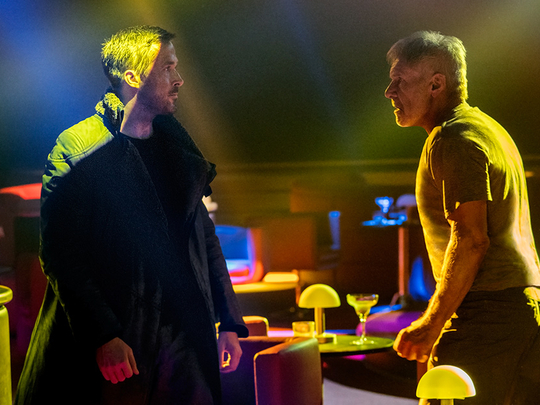
You know that exact moment when you realise a dream is turning into a nightmare? Watching Blade Runner: 2049 is that moment multiplied: the viewer constantly walking the tight rope between a gorgeous, lucid dream and a visceral, waking nightmare.
Ridley Scott’s 1982 feature set in the dytopic future of 2019, a loose adaptation of Philip K. Dick’s Do Androids Dream of Electric Sheep?, while a meditation on religious symbology and basic existential questions, also laid the visual and thematic blueprint for hundreds of science fiction movies to come. And while Denis Villeneuve’s sequel does not break or create genre conventions, it heroically builds on the original without being entirely beholden to it. So if you’re wondering if we’ve hit peak sequelitis, we’re here to tell you, “not yet”.
The year is 2049 and LA has become even more decrepit since the last time we saw it, a city of eternal night and constant rain. As in 2019, now corporations run the world, not governments. Tyrell Corporation has been bought over by Wallace, run by the milky-eyed Niander Wallace (a shaky Jared Leto), on an undeterred mission to supply slave replicants (synthetic or genetically engineered beings), to rich, off-world colonies.
One such replicant, KD6.3-7 (Ryan Gosling), or K, is a cop/blade runner whose job is to hunt down or “retire” any former models of replicants that may still be lurking around.
One of his missions leads him to Sapper Morton (Dave Bautista in a short but sturdy outing) and their interaction ends in K discovering a secret (or a “miracle” as Morton put it) that could result in a revolution, a certain kind of freedom. K’s quest to solve the mystery of this miracle informs the rest of this movie, and repeats the question of the first film: “Do memories make us human?”
Blade Runner: 2049 is a Villeneuve film through and through. His mastery over the visual form grows with every film and in 2049, the words come sparingly, but the sights hold all the clues. The streets of LA are a claustrophobic jungle of stacked buildings, each matchbox room, spilling into the next, where the masses exist in a beaten down hum, moving from one day to the next in cycles of poverty and consumption. The themes are both relevant and prophetic: the moral implications of creating AI, the value of life (artificial or human), the nature of emotions and the value of memories.
Cinematographer Roger Deakins, who is frequent collaborator with directors Ethan and Joel Coen, as well as Villeneuve, supports the director in transforming his vision to the big screen (and what this on the big screen, you must) — from the radioactive ruins of Las Vegas to sterile worm farms, from gargantuan dams to unruly and terrifying oceans, Deakins paints a picture so terribly realistic, we’re forced to reckon with our own future as a species. Combine this with the booming and ethereal background score by Hans Zimmer and Benjamin Wallfisch, and you have a masterpiece in your hands.
The women in Vielleneuve’s sequel have a lot more to do as well. Whether its Robin Wright’s Joshi, a Lieutenant commander sympathetic to K, but at the same time an upholder of the replicant-human divide; or Ana de Armas’ shimmering Joi, K’s holographic girlfriend, who seems more real than K at times; or even Sylvia Hoeks as Luv, who is Wallace’s replicant enforcer, hunting own K as he races to solve his all-important mystery.
And for those of you have seen the original film and remember how it ended, you will be pleased to know that Harrison Ford’s return as former blade runner Deckard is not simply fan service. His presence in the film electrifies Gosling’s performance to a whole new level and watching the two wrestle (physically and emotionally) is a gift to quality-starved audiences.
But if you’re looking for a single reason to watch this movie, make it Gosling. There are two moments in the film where his cool visage is visibly shaken by an unexplainable emotional tide, and those two moments alone will make up the price of entry. Give the man a 100 Oscars and it won’t do justice.
To summarise, treat yourself this week with a trip to 2049. You may return with more questions than before you went in, but at least it’ll make you think.









